 SELECTED
ISSUE
SELECTED
ISSUE
|
|
Leisure Management - Green matters

Sustainability

|
|
| Green matters
|
|
|
|
|
As energy bills soar, sports clubs are aiming for long-term sustainability and cost reductions. We look at a range of initiatives, products and projects being developed in the industry
|
|

|
Dow Chemical Company - Sochi 2014

The Dow Chemical Company, already the Official Chemistry Company of the Olympic Games, has been announced by the Sochi 2014 Organizing Committee as the Official Carbon Partner of the XXII Olympic Winter Olympic Games, to be staged from 7-23 February, 2014. The direct carbon footprint associated with the delivery of the Games will be mitigated through the implementation of energy-efficient technologies, with improved greenhouse gas (GHG) emissions performance in the key areas of infrastructure, industry and agriculture. All projects will be implemented in the Russian Federation, generating savings and long-lasting benefits to the host country’s economy.
Dmitry Chernyshenko, president of the Sochi 2014 Olympic Winter Games Organizing Committee, said: “We aim to be the most innovative Olympic Winter Games in history. The positive impact will leave behind a heritage not only to Sochi and the Krasnodar Region, but to Russia and its people for generations to come,”
During the Games, Dow will lead an initiative to mitigate the direct carbon footprint associated with the hosting of the Games through the implementation of energy-efficient technologies, resulting in a net decrease of greenhouse gas emissions in the key areas of infrastructure, industry and agriculture.
Amy Millslagle, marketing vice president, Dow Olympic Operations, says: “In the area of Games infrastructure, buildings contribute nearly 40 per cent of the man made GHG emissions. Improvements that reduce the heat transfer across the building enclosure have a large impact on the energy consumed to condition the interior. We’re working with local partners in Russia to introduce high-performance polyurethane foam as insulation material for windows and other potential sources of cold air infiltration, ensuring less energy usage by newly-built apartments.”
Public engagement will also play an important role on the journey to help transform Sochi 2014 into a Games city with minimal impact on the climate. Dow will also partner with Offsetters Climate Solutions – the supplier of carbon offsets to the Vancouver Organizing Committee in 2010 – to develop measurement tools to account for the carbon benefits of the solutions implemented in Russia.
ERM – a global provider of environmental, health, safety, risk and social consulting services – will provide critical review and assurance for the partnership.
| |
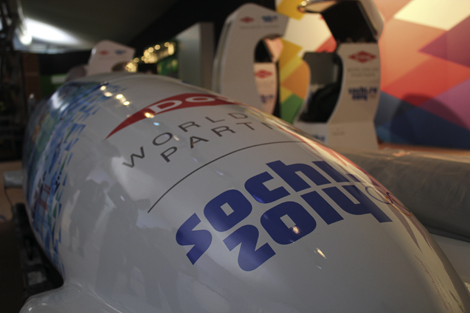

|

Dow, the official chenistry company of the Games, will introduce a range of green schemes at Sochi |
|

|
Philips - lean lighting

Lighting accounts for 19 per cent of the world’s electricity consumption. The financial and environmental pressures facing sport clubs and facilities today can be eased by making informed choices about lighting requirements. Choices that not only result in energy, carbon and cost savings but also enhance the fan and player experience, with improved quality of light and even a reduction in light pollution.
The right lighting can unlock the potential of a facility, increasing usage and driving revenue. Significant savings are possible by considering a few key factors such as Design Maintenance Factor (MF), Total Light Output Ratio (TLOR) and Total Cost of Ownership (TCO).
Lighting typically consists of a light source, luminaire (containing optical means) and control gear to power the light source. When looking for a new lighting system it’s essential to consider the TCO and not just the initial investment. By carefully considering all aspects, the system will continue to provide exceptional light throughout its life, on the condition that the system is maintained as recommended by the manufacturer, which should be accounted for in the design stages. This is the amount that the light will depreciate in between maintenance activities such as lamp changes.
It’s also important to consider the TLOR of the luminaire, applicable to all light sources including LED. Light output will be lost through the optical system of the lighting unit, plus reflected light, because of its nature, can sometimes direct light outside the task area wasting light and energy. The light source inside the luminaire has a flux value expressed in lumens, with some having higher flux values than others. Once this is multiplied by the TLOR of the luminaire, this can sometimes equal out.
Good TLOR values can reach 0.85 for recreational use and more for stadiums where consumption is a major factor. When looking into the total power consumption of a system, there will almost certainly be additional energy losses within the control gear. This is more significant in the discharge lighting currently used for sports pitches, therefore, when calculating the overall energy consumption this should include the total system’ Once you have this, the efficiency of each light can be calculated.
Case study - streetly
Streetly Lawn Tennis Club replaced all its asymmetrical tungsten luminaires with more efficient double asymmetric metal halide types, where lighting is forced in a downward-only direction.
The result was a 60 per cent reduction in costs and a 100 per cent increase in lighting levels to meet LTA standards. Will Rogers, the club’s Director of Tennis says: “We’ve been delighted with help received from Philips Lighting in the design, sourcing and installation of our new floodlights. We looked at a number of systems and chose Philips’ 1000W OptiVision floodlight luminaires.
“We’ve now reduced our electricity usage and maintenance costs by over 60 per cent. Glare and spillage from the old tungsten halogen lights has been reduced and our members and visiting teams have been delighted with the greatly improved quality of the lighting.”
sport-kit.net keywords: Philips Lighting
|

|
The:Square3 - sustainable living

New sport-inspired mixed-use development The:Square3, which will consist of three towers of gold, silver and bronze, is expected to open in Berlin in 2017.
Located near the Olympic sports centre and Europe’s largest urban nature reserve, The:Square3 urban quarter will offer sports-themed hotels, a medical and research centre, sports education facilities and sport-themed retail experiences all in one place. There will also be offices for sports companies and clubs, 1,000 apartments and a green piazza.
Conceived by Berlin-based developer Moritz Gruppg and designed by architects LAVA, the 146,000sq m (1.5m sq ft) urban project is based on three themes: sport, life and nature.
Sustainability is a key feature, the building shapes will maximise daylight, reducing the need for artifical light and energy use, while naturally ventilated spaces throughout the complex will minimise mechanical ventilation. Rainwater will also be collected and reused.
Rising above a sport ‘podium’ will be the three towers of varying heights, with Olympic themed facades. Each tower will be tapered towards the top to maximise sunlight, views and ventilation.
The life aspect of the project will focus on the essentials for a high-quality and healthy urban existence. Meanwhile, nature will be found throughout the development with green features in all three blocks. The apartments will have diagonally placed spaces, green roof-scapes with cascading balconies and integrated garden courtyards, and will overlook playing fields.
Dirk Moritz, MD of Moritz Grouppe said: “For us The:Square3 is more than just a development project, it’s a philosophy. Living in a big city is an experience – you can’t just order it online.
“A good mix of people, culture and lifestyles is what makes a city interesting and worth living in. Our goal is to answer the question: “How do we want to live in the future?”
| |
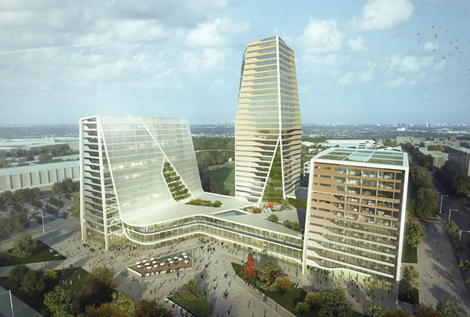

|

The sports-themed project – designed by architects LAVA – will be based on sustainability and will include three towers of gold, silver and bronze |
| |


|
| Eco solutions include green ‘roof-scapes’ |
| |
|

|
Miele - green washing

Sports venues process a large amount of laundry and so laundry equipment is often used many times a day and for long periods of time. If your on-site washing machine or dryer is more than a decade old, it’s consuming a lot more electricity than it needs to.
Today’s major appliances do not consume electricity the way older models do. Miele Professional has put energy efficiency and minimising running costs at the heart of product development, which means any new appliance you buy today will use less electricity than the model you’re replacing.
There are energy-efficient machines such as Miele’s heat-pump dryers that require no ducting and easy to install.
Miele’s heat-pump technology brings drying times for a 10kg of laundry load down to only 44 minutes. This means that only 0.21kWh* is required per kg of laundry, equating to a reduction in energy consumption of 60 per cent, compared with a conventional Miele vented dryer with the same load capacity.
Customers have reported that in 18 months they’ve already made savings and in five years, Miele predicts that heat pump dryers will completely take over from condenser dryers.
* Basis of calculation: 100kg of laundry per day, 250 days per year / Electricity costs: E0.19/kWh, reduction in residual moisture from 50 to 0 per cent.
sport-kit.net keywords: Miele
| |
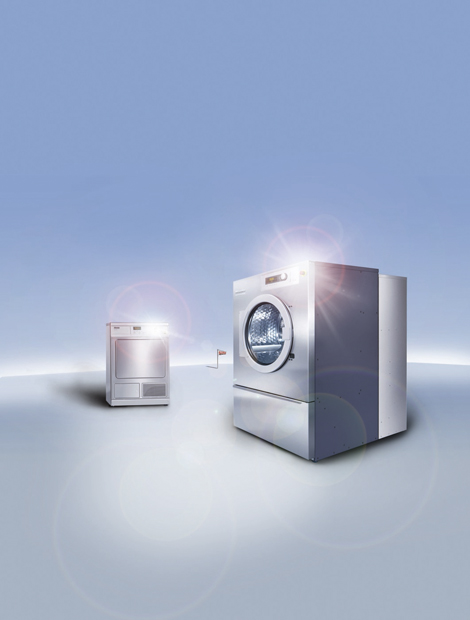

|

Efficiency is at the heart of Miele’s products |
|

|
SportsArt - Human energy put to use

Following the installation of a SportsArt Green System® at the Spectrum Leisure Centre back in December last year, the centre has reported that the system paid dividends in the first three months. It works by harnessing exercise power and converting this into usable energy
Ian Hirst, chairman of Slam, the charity that runs the Spectrum Leisure Centre said: “This is very exciting as we were the first centre to purchase the new SportsArt Green System® and can state that it has been a great success. We can report energy savings of £600 over that short period of time.
“At the centre, we strive to provide innovation in the way we operate and constantly look to reduce our carbon footprint. The new SportsArt Green System® has provided that technology to assist us in supporting the environment plus the community we serve.”
The new power-generating gym equipment uses its members’ exertions to produce power. At Spectrum, a pod of 10 SportsArt elliptical trainers and cycles attached to an inverter harnessess the power from exercise and feeds it back into the power grid as usable energy. This can save facilities thousands of pounds in energy costs over the year.
“This green equipment is the stepping stone for us to introduce more traditional styles of renewable energy through energy efficient LED Lighting, Solar PV and Biomass. This product sits with these technologies in helping us help the environment and the community we work with,” continued Hirst SportsArt Fitness’ managing director Mark Turner says: “One of the biggest costs for any sports facility is electricity and the new fitness machines are the perfect way of tackling those bills.
“SportsArt Fitness designed and built the Green System® and we are now at a point where these machines are viable and proving to be environmentally friendly, energy efficient and providing gyms with considerable energy cost savings. The new pieces of equipment include recumbent bikes, upright bikes and elliptical trainers – all capable of producing up to 2,000 watts an hour and more importantly, cost the same as other SportsArt machines.
“With Spectrum Leisure’s evidence of energy savings, we believe this will encourage other gyms and sports facilities to consider our Green System for increased efficiencies and reduced costs.”
sport-kit.net keywords: SportsArt Fitness
| |
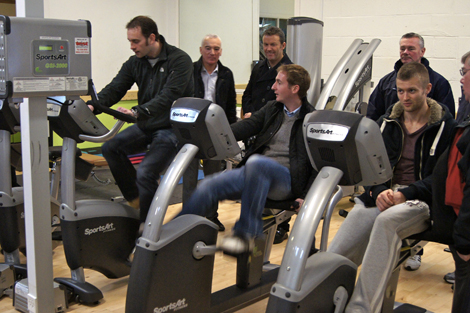

|

The energy provided by the members – and the equipment – can save facilities thousands of pounds |
|

|
SudsSports Thornton Sports

SudsSports is an innovative sustainable drainage system from Thornton Sports which has been designed as a substitute for the piped drainage scheme traditionally used
at sports facilities.
Consisting of specially designed light-weight interlocking plastic units, the system has been developed for sites that experience water management issues, heavily sloping ground levels or rainwater harvesting requirements. Its flexible nature allows the system to be installed as a full ‘blanket’ underneath a pitch, or as conduits, to potentially offer a cost-effective alternative to a traditional drainage system.
The units are installed as a strong inter-locking system, designed to provide both lateral and vertical restraint between adjacent units. It has been designed with sustainability in mind and has a number of eco-friendly features. Made out of recycled – and recyclable – materials, it has in-built rainwater harvesting and ensures greenfield run off rates aren’t exceeded. There’s no need for a macadam layer, avoiding any contamination legacy.
The system is ideal for surface projects with high susceptibility to flooding, abnormal ground conditions, sloping levels and ineffective water management.
sport-kit.net keywords: Thornton Sports
| |
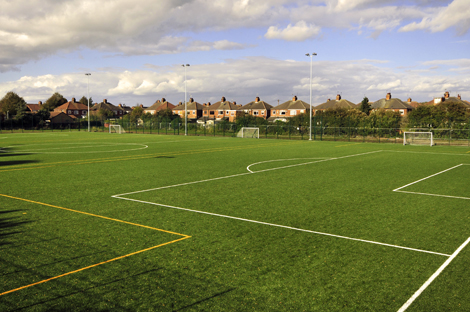

|

The system is based on an inter-locking system that has a number of eco-friendly elements |
|

|
GEO for Elmwood

Elmwood Golf Club in Cupar, Fife, has been awarded golf’s international ecolabel – GEO Certification. The club, built on previously fertile agricultural land, has established itself as not just a golf club but also a training centre and a centre of excellence for sustainability in golf.
The sought-after GEO Certified ecolabel is awarded to courses which work through the free OnCourse sustainability support programme, and fulfil comprehensive criteria covering nature; water; energy; supply chains; environmental quality and communities.
Some of the practical measures undertaken at Elmwood include the creation of more than 2ha (4.9 acres) of new ecological grasslands; the reuse of artificial turf from St Andrews University sports pitches; and the use of timer-controlled lighting for driving range and car park. The club also has established an outreach programme for local school children.
|

|
Zero waste events launched for the UK

A new industry road map, entitled Zero Waste Events: a 2020 vision, has been launched for the sports events sector. The scheme has the goal of no waste being sent to landfill from UK events by the end of the decade.
The challenge will be significant – the events sector is very complex and comprises thousands of operators of all sizes. It supports around 25,000 businesses and some 500,000 full time jobs. It has a significant impact on the economy, with a current value of £36bn – projected to rise to £48bn by 2020. The industry, however, could maximise the opportunities afforded by reducing waste to its advantage.
While some of the sector has achieved as much as a 50 per cent recycling rate for events, most are averaging just 15 per cent, with a large amount of waste going direct to landfill.
The new roadmap has been developed by WRAP (Waste & Resources Action Programme), collaborating with the events industry as part of its work on the European Pathway to Zero Waste (EPOW) project. The roadmap draws on lessons learned from the London 2012 Olympic and Paralympic Games, creating a series of steps that events and the industry can take to achieve sustainable events. The roadmap is the first stage in raising awareness of the positive impact which effective management of waste has on the delivery of events, both economically and environmentally.
Specifically it sets out a clear vision for how the industry can achieve zero waste to landfill from the events sector by 2020. It also challenges the industry to consider how it can work more in partnership across the whole supply chainw and highlights the steps that need to be considered when preparing for and delivering a zero waste event.
Dr Liz Goodwin, CEO of WRAP, said: “The London 2012 Olympics showed just what could be achieved by a clear commitment, by preventing waste and managing it sustainably.
“Making waste prevention part of an event’s plan delivers significant savings for businesses large and small. It will benefit all, from local community activities up to large scale UK events like the Ryder Cup and the Commonwealth Games 2014 in Glasgow. The events industry roadmap was developed to support business growth by managing resources efficiently. It’s a simple vision, but it’s only by the industry individually and collectively taking on the challenge, that it can be realised.”
Details: www.wrap.org.uk
|
 |
| Originally published in Sports Management 2013 issue 1
|
|
 |
|
|
|
|
|
| | | | |